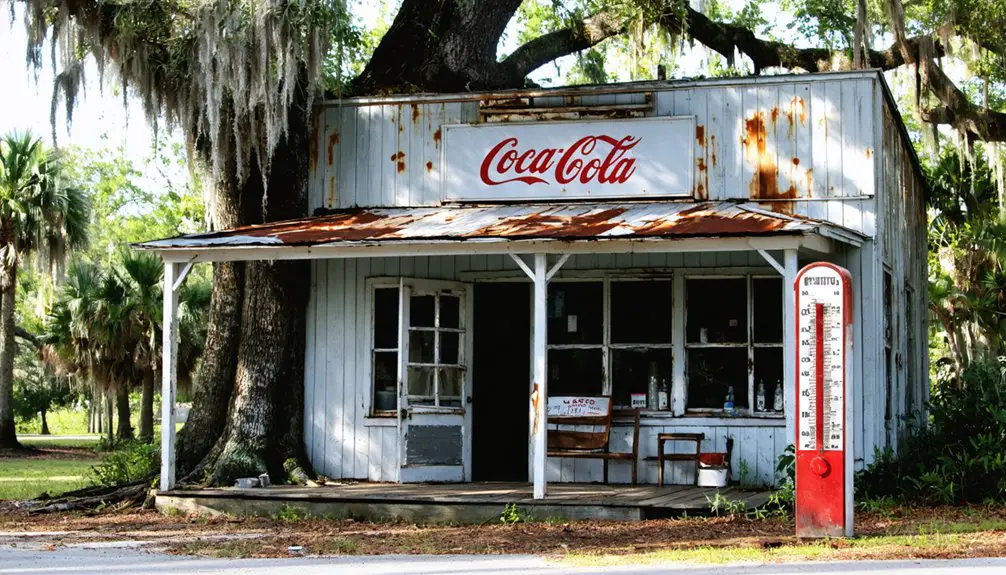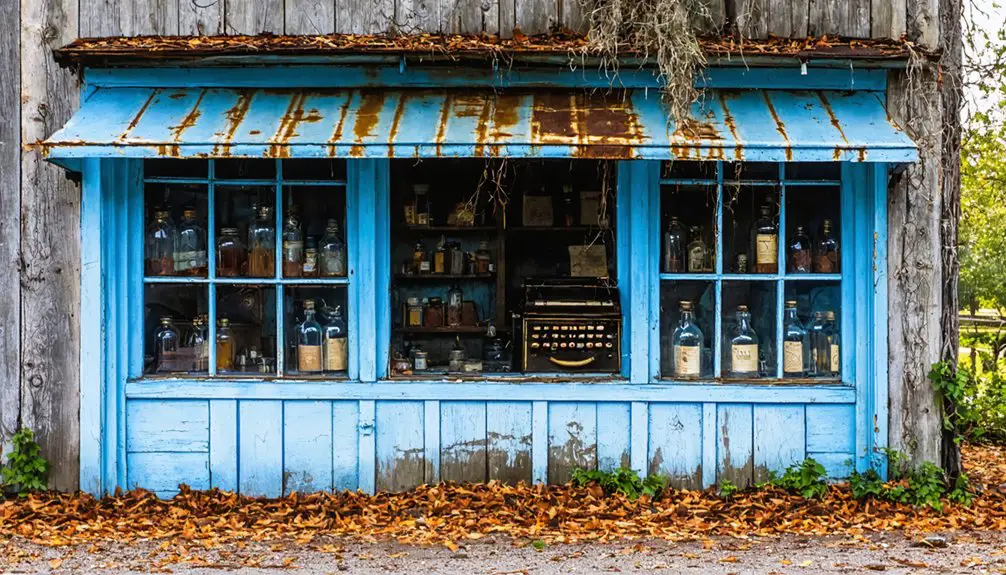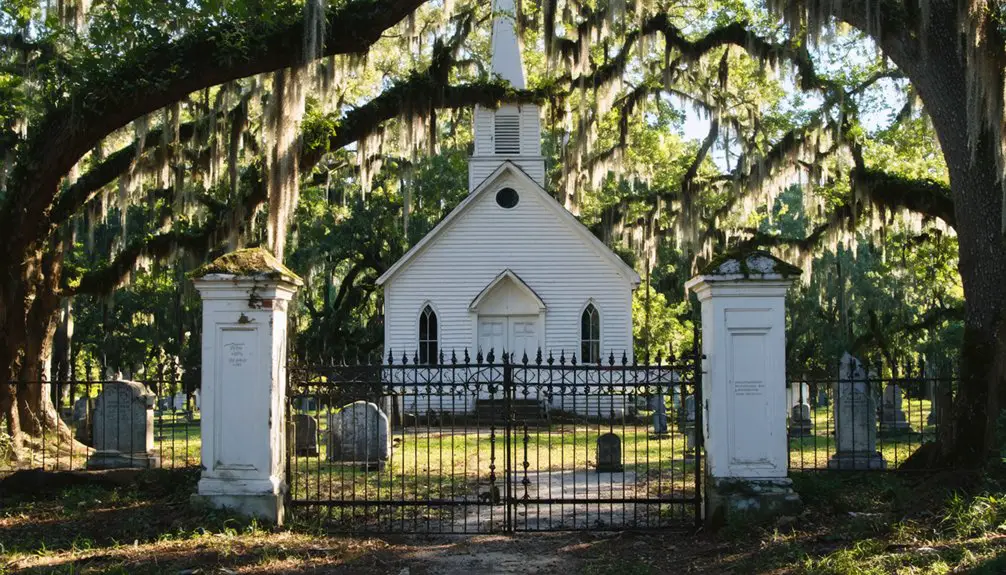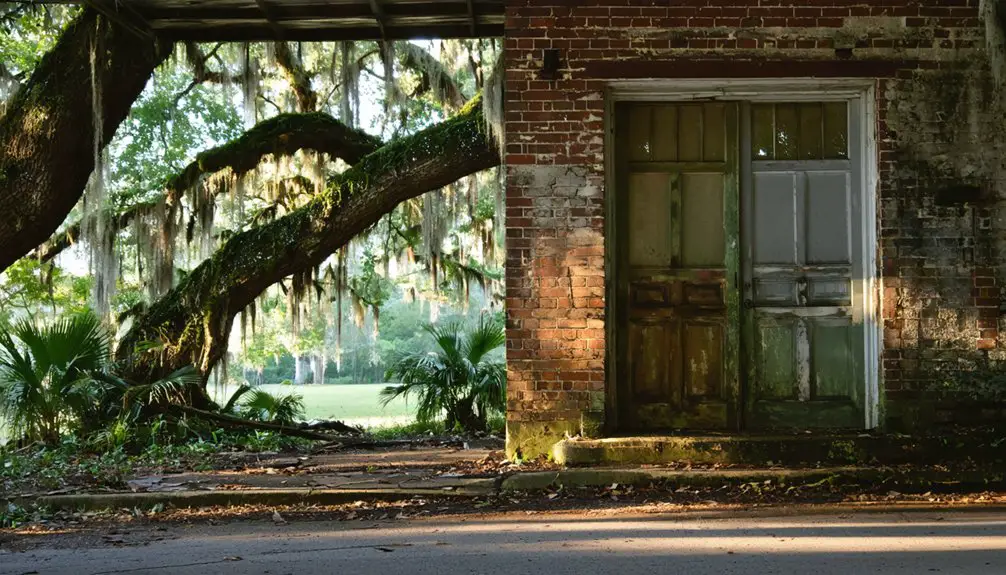You’ll find Jessamine’s ghost town story in Pasco County, where it flourished from 1888 around Jessamine Gardens and Jessamine Lake. The agricultural settlement thrived on Pike and Ellsworth’s seed business, with families tending gardens and sharing seasonal celebrations at Burns Road Community Center. By 1919, major transportation shifts sealed the town’s fate when Florida State Road 41 and the railroad bypassed it. Today, only road names and the lake mark where this close-knit community once bloomed.
Key Takeaways
- Jessamine was established in 1888 around Jessamine Gardens near Jessamine Lake, with its last documented mention appearing in 1919.
- The town’s economy centered around Pike and Ellsworth’s seed business, logging operations, and turpentine production.
- Transportation changes, including the rerouting of Florida State Road 41 and railroad relocations, led to the town’s isolation and decline.
- The community’s agricultural heritage featured rare Florida flowers and fruits, with seasonal events like “Fruit Fest” binding residents together.
- Today, only Jessamine Lake and road names remain as physical evidence of the ghost town’s existence in Pasco County.
The Birth of a Late 19th Century Settlement
While many Florida settlements emerged during the post-Reconstruction era, Jessamine carved out its unique identity in 1888 when settlers established their community around the picturesque Jessamine Gardens near the south shore of Jessamine Lake.
Founded in 1888, Jessamine blossomed as a distinctive Florida settlement, centered around its namesake gardens beside tranquil Jessamine Lake.
You’ll find that Jessamine’s settlement patterns reflected the era’s push for new communities along transportation routes, with the town strategically positioned at the intersection of James Road and Blanton Road. Much like browsing options today, visitors explored the town’s various pathways to discover its hidden treasures.
The early alignment of Florida State Road 41 provided essential connections to neighboring settlements like Blanton and Garlock. The community dynamics centered on the Gardens, which served as both the town’s namesake and heart.
Unlike some regional settlements focused on mining or industry, Jessamine’s founders embraced a more pastoral vision, emphasizing horticulture and garden-based commerce. The community’s presence gradually diminished until its last recorded mention appeared in the Tampa Bay Tribune in 1919.
Life Around Jessamine Gardens
If you’d visited Jessamine Gardens in the late 1800s, you’d have found a bustling agricultural community centered around Pike and Ellsworth’s thriving seed and plant business.
Your daily routines would’ve followed the natural rhythms of garden work, from morning plant care to afternoon seed sorting, all while coordinating with neighbors through the local post office. After tending to the gardens, many residents would prepare special teas from herbs grown in their family plots. Much like the vibrant azalea blooms that now grace Eden Gardens State Park each spring, the community flourished with colorful flowering plants.
You might’ve joined fellow residents for informal gatherings where they exchanged gardening tips and plants, strengthening the bonds of this close-knit horticultural settlement.
Agricultural Heritage and Impact
Prosperity bloomed alongside the founding of Jessamine Gardens in 1887, when Walter N. Pike and William J. Ellsworth established their pioneering seed and plant business.
You’d have found their nursery at the heart of agricultural innovation in Pasco County, specializing in rare Florida flowers and fruits that thrived in the subtropical climate.
The Gardens weren’t just a commercial enterprise – they became a center for horticultural education through their detailed catalogs, which served as essential guides for farmers and gardeners throughout the region. Their detailed catalog publications attracted tourists and settlers looking to establish their own gardens in Florida.
Their work transformed local agriculture by introducing diverse plant varieties and cultivation techniques. The operation expanded significantly over time, with records showing 250 crates of kumquats being shipped from Jessamine Groves in 1914.
With a post office on-site, they connected growers across Florida, spreading knowledge about everything from ornamental palms to fruit trees, ultimately shaping the state’s agricultural landscape for generations to come.
Daily Life at Gardens
Beyond the bustling nursery operations, daily life in Jessamine Gardens revolved around a close-knit community where homes and gardens intertwined. You’d find families adapting unique spaces, turning old clubhouses into homes and theater stages into bedrooms, while maintaining their cherished garden traditions.
Star jasmine vines climbed walls and fences, requiring careful garden maintenance through Florida’s challenging seasons. Year-round beauty came from the evergreen vines’ glossy foliage. Multi-generational families made their mark by transforming the landscape, surrounding their homes with fragrant groves that served both beauty and function. The Orange City Orchestra often performed to entertain local residents during community gatherings.
You’d see neighbors tending to their heat-tolerant plants, sharing gardening wisdom, and gathering at converted community buildings. As roads and highways evolved around them, residents preserved their quiet way of life, creating lasting homesteads that balanced agricultural roots with family living.
Community Social Activities
When strolling through Jessamine Gardens, you’d encounter a vibrant tapestry of community life woven through seasonal gatherings and outdoor activities. You’d find yourself drawn to the “Fruit Fest” celebrations, where neighbors shared garden harvests and expert knowledge while fostering community bonding through food sampling and tastings.
The Burns Road Community Center served as a hub for social engagement, offering everything from fitness classes to cultural events. You could join walking groups, birdwatching expeditions, or kayaking adventures, all designed to improve both physical and mental wellbeing. Water-based activities allowed residents with joint issues to stay active and connected. Regular health and wellness events provided opportunities for residents to stay active and connected.
The gardens themselves hosted educational workshops and lectures, while volunteer-led initiatives like food drives strengthened community ties. Through these shared experiences, you’d discover a close-knit community where wellness and social connection flourished naturally among the garden paths.
Transportation Routes and Regional Connections
Transportation networks played an essential role in Jessamine’s development and eventual decline. You’ll find the town’s early prominence centered around Florida State Road 41 (later CR 41), which intersected at James Road and Blanton Road near Jessamine Lake.
This transportation evolution proved both beneficial and challenging – while the road initially brought significance to the community, its northward rerouting between 1988-2012 effectively isolated the town.
Regional connectivity through the Orange Belt Railroad, though not directly serving Jessamine, influenced nearby settlements like Blanton. The railroad’s presence supported important industries including turpentine, logging, and mining throughout the region.
When you explore the area today, you can still spot remnants of these historic transportation networks, though they’ve long since ceased operating.
Economic Rise and Fall

The economic story of Jessamine began with the town’s rich natural resources, particularly its vast cypress and pine forests. You’d find a bustling economy built around logging and turpentine operations, with massive sawmills employing countless workers.
However, the town’s economic sustainability suffered from tight corporate control through company stores and limited wage freedom.
Key elements that shaped Jessamine’s economic trajectory:
- Workers earned partial wages in company scrip, binding them to company-owned stores
- Sawmill smoke filled the air as timber production reached peak southern U.S. levels
- Devastating fires swept through processing facilities, causing massive financial losses
- Deforestation gradually stripped the land of its valuable timber resources
Poor labor relations and dwindling resources eventually led to Jessamine’s economic collapse, turning this once-thriving timber town into a ghost of its former self.
Traces in Historical Records
Despite its brief existence, Jessamine’s historical footprint remains traceable through various archived documents and maps from the late 19th to early 20th centuries.
Brief but not forgotten, Jessamine’s legacy lives on through century-old maps and archived records of its fleeting existence.
You’ll find evidence of the settlement patterns in historical topographical maps, showing Jessamine’s position at the crossroads of James and Blanton Roads near Jessamine Lake. The community’s historical significance is particularly visible in transportation records, which document the original route of State Road 41 through the settlement.
The Tampa Bay Tribune’s 1919 mention marks the last known published reference to this ghost town, while surrounding communities like Blanton provide valuable context for understanding regional development.
Land surveys, road records, and scattered newspaper clippings help piece together Jessamine’s story, though detailed census and postal records remain elusive.
The Last Days of a Forgotten Town

You’d find Jessamine’s final traces in newspaper records around 1919, marking the quiet end of this once-bustling agricultural community.
As transportation routes shifted away from the town in later decades, particularly the rerouting of Route 41, you’d witness the severing of essential connections that had kept the settlement alive.
The empty fields where Jessamine Gardens once flourished now stand as silent witnesses to the town’s gradual fade into ghost town status, with neither businesses nor residents remaining to tell its story.
Newspaper’s Final Mention
As print media gradually lost interest in Jessamine’s affairs, Tampa Bay Tribune published what would become the town’s final newspaper mention in 1919.
This last reference marked the end of Jessamine’s documented presence in regional newspapers, signaling its fade into historical obscurity. Through archival research, you’ll find that this final mention served as a vital timestamp in understanding the town’s decline.
- Local farmers gathering for their last recorded community event
- Horse-drawn wagons still traversing the dusty roads to neighboring Blanton
- The once-bustling Jessamine Gardens falling silent
- Wooden storefronts weathering away as commerce shifted elsewhere
The newspaper significance of this 1919 mention can’t be overstated – it’s effectively Jessamine’s death certificate in print, marking when this once-promising settlement slipped from public consciousness.
Transportation Routes Fade Away
While travelers once frequented the busy crossroads of Jessamine, major transportation shifts in the late 20th century sealed the town’s fate. You’d hardly recognize the transportation history that once defined this vibrant community.
Between 1988 and 2012, Florida State Road 41 abandoned its original path through town, redirecting traffic northward along Blanton Road. Even before the route changes, the Atlantic Coast Line Railroad had already dealt Jessamine a crushing blow by relocating its depot in 1921.
As rail service dwindled and highways bypassed the town, you would’ve watched Jessamine’s essential connections slowly disappear. The community that once thrived at the intersection of James Road and Blanton Road found itself cut off from both rail and road networks, transforming from a bustling waypoint into a silent ghost town.
Empty Gardens Remain Silent
Once bustling with life and activity, Jessamine Gardens now stands as a silent tribute to the town’s gradual fade into obscurity.
As you walk through these abandoned gardens, you’ll find nature’s reclamation has transformed cultivated plots into wild landscapes, where Florida’s native flora freely grows among forgotten homesteads.
- Weathered garden plots lie dormant where residents once tended flourishing vegetables and flowers.
- Overgrown pathways wind through patches of abandoned beauty, leading to empty homesites.
- Silent fields stretch toward Jessamine Lake, their agricultural purpose long surrendered to wilderness.
- Wild vegetation creeps through former garden spaces, creating natural habitats where cultivation once ruled.
The gardens’ transformation from managed plots to untamed spaces mirrors the community’s dissolution, as the last mentions of Jessamine’s liveliness vanished from local papers after 1919.
Legacy in Modern Pasco County

Though Jessamine’s physical structures have vanished from Pasco County’s landscape, the ghost town’s legacy persists through modern geographical markers and infrastructure.
You’ll find traces of its cultural significance in the road names like James Road and Blanton Road, which intersect near the original settlement. The historic community’s memory lives on through Jessamine Lake, a natural landmark that once defined the town’s southern boundary.
While FL 41’s rerouting between 1988 and 2012 further isolated the former settlement, local historical preservation efforts guarantee Jessamine’s story endures.
Historical societies like Fivay.org document the ghost town’s role in post-Civil War Florida, and you can explore its heritage through educational projects and ghost town tourism initiatives that celebrate Pasco County’s pioneering spirit.
Frequently Asked Questions
What Natural Disasters, if Any, Contributed to Jessamine’s Abandonment?
You won’t find any natural events directly causing Jessamine’s abandonment. Instead, the town’s fate was sealed by economic decline, particularly when major transportation routes shifted away from the community.
Were There Any Schools or Churches Established in Jessamine?
You won’t find any documented school history or church significance in this settlement. Despite the era’s typical practice of establishing community institutions, there’s no evidence of either being built here.
What Was the Peak Population of Jessamine During Its Existence?
You’ll find that while exact peak population records aren’t preserved, historical growth patterns of similar mining towns suggest Jessamine likely reached between 150-300 residents during its phosphate boom years.
Did Any Notable Historical Figures Ever Visit or Live in Jessamine?
You won’t find any famous visitors or residents in Jessamine’s history. There’s no documented evidence of historically significant people ever staying in this small settlement during its brief existence from 1888-1919.
What Crops or Products Were Primarily Grown in Jessamine Gardens?
While you’d find traditional citrus and cotton early on, Jessamine Gardens later thrived with wholesale tropical foliage and ornamental plants, showcasing remarkable crops diversity through specialized garden techniques in their nursery operations.
References
- https://www.youtube.com/watch?v=TxBONhwNi1k
- http://www.gribblenation.org/2018/08/florida-friday-abandonment-on.html
- https://en.wikipedia.org/wiki/List_of_ghost_towns_in_Florida
- https://floridahistoryblog.com/search/
- https://www.tiktok.com/@beyondflorida/video/7265851333121559850
- https://www.tiktok.com/@socialshepherdadventures/video/7342301852702100778
- https://www.youtube.com/watch?v=ov9YSsKtbDs
- https://www.visitjessamine.com/things-to-do
- https://floridahistoryblog.com/state/counties/
- https://www.nbbd.com/godo/PritchardHouse/gardens/index.html



